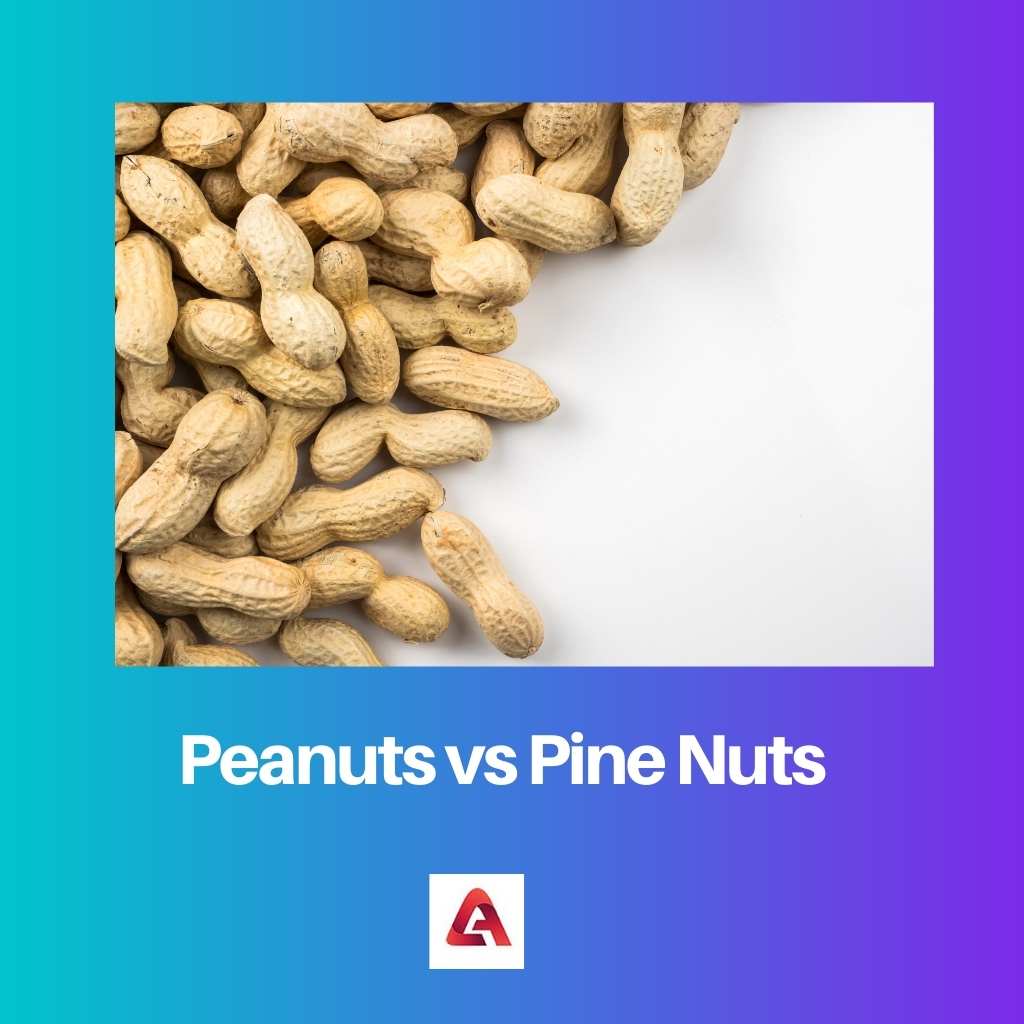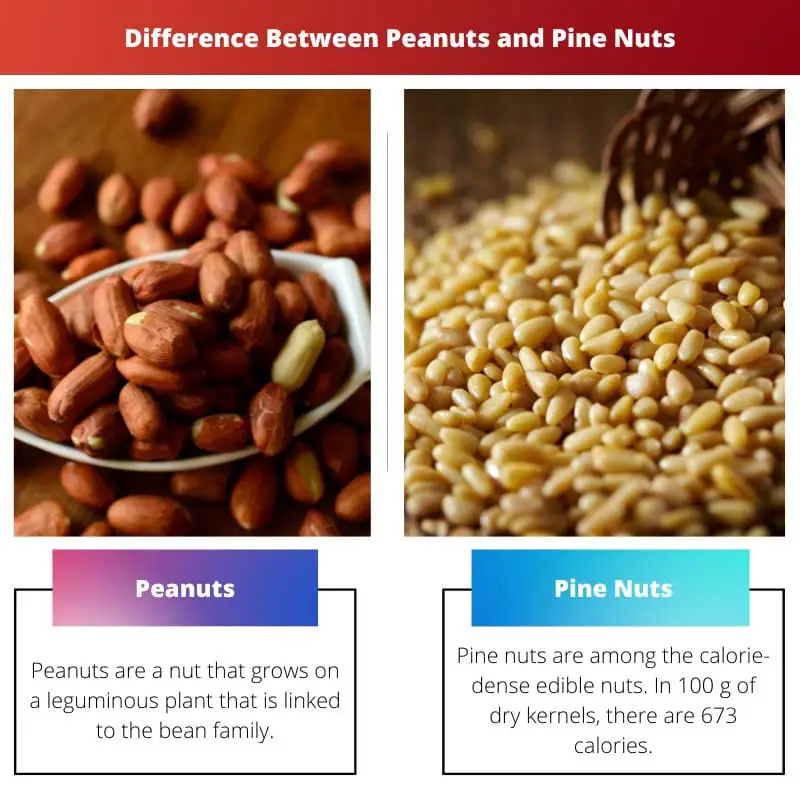Peanuts and pine nuts are both categorized as nuts, although they fall into two different categories. For someone who isn’t familiar with it, this could be extremely perplexing. Mostly because persons who have a peanut allergy are more likely to have a nut allergy as well.
They are also grown in a variety of trees. They grow in a variety of environments and provide a variety of services for humans. To tell them apart, we must first understand their respective qualities.
Key Takeaways
- Peanuts are legumes that grow underground, while pine nuts are seeds harvested from pine cones.
- Peanuts have a distinct, earthy flavor and are less expensive than pine nuts, known for their rich, buttery taste and higher price tag.
- Both peanuts and pine nuts are nutritious and versatile ingredients used in various culinary applications, from snacks to main dishes.
Peanuts vs Pine Nuts
Pine nuts are the edible seeds of pine trees, whereas peanuts are legumes that grow underground. Peanuts have a mild, nutty taste and are crunchy, while pine nuts have a buttery and rich taste. Pine nuts have higher fat and calories than peanuts which are good sources of vitamins and minerals.

Peanuts are a nut that grows on a leguminous plant that is linked to the bean family. However, most people are unaware that there are hundreds of different types of peanuts! There are four types of peanuts: runner, Virginia, Spanish, and Valencia. When you open the shell, you’ll see a thin, hard white layer on the outside.
Pine nuts are among the calorie-dense edible nuts. In 100 g of dry kernels, there are 673 calories. They also include a wide range of phytochemicals, vitamins, and minerals that are good for your health. Pine nuts are high in iron, protein, and magnesium, all of which might help you feel energized. Vitamin E’s antioxidant capabilities may help keep your skin looking young and healthy.
Comparison Table
| Parameters of Comparison | Peanuts | Pine Nuts |
|---|---|---|
| Calories | 567 | 673 |
| Protein | 25.8 grams | 13.69 grams |
| Carbs | 16.13 grams | 13.08 grams |
| Fat | 49.24 grams | 68.37 grams |
| Water Content | 10.5% | 2% |
| Taste | Bland and nutty | Bitter or metallic |
What are Peanuts?
Peanuts are South American legumes that are used to make peanut butter. They include calories and proteins, making them good for the human body. They belong to a subgroup of the peanut family.
Peanut is a colloquial name for Arachis Hypogae, which is the botanical name for peanut. Food, energy, fat, and protein are all found in peanuts. Chocolate, cake, cookies, pudding, spreads, and other confections include them.
Peanuts can be utilized as a source of protein for animals. They can also be used as a dyeing pigment, peanut fiber can be used to make paper, and peanut butter can be used to polish surfaces.
Peanuts are the most widely consumed nut in the world and are easy to digest. They’re in a lot of recipes, and they’re even in peanut butter! Peanuts can be eaten raw, roasted, or salted, making them a flexible food. They can be found at a variety of health food stores, supermarkets, and even farmer’s markets.
Peanut is a widely farmed crop that is mostly grown for its seed. It contains a lot of protein, as well as healthy fats, vitamin A, vitamin E, niacin, and a variety of other nutrients. Peanuts are supposed to come in four different types.
Although they have a flavor similar to nuts such as almonds, the crop does not fall in the nut group, despite its name. It’s a legume, after all. Because some people are sensitive to the crop, we see warnings on food packaging indicating the product contains peanuts as a precaution. Many restaurants now ask if somebody has a peanut allergy before cooking.

What are Pine Nuts?
Pines are one of the gluten-free tree nuts, which makes them a common ingredient in gluten-free food formulas. Such formula formulations can be a nutritional alternative for people who have a wheat dietary allergy or celiac disease.
The edible pine seeds are known as pión, pinole, or pignoli are also known as pión, pinole, and pignoli (family Pinaceae, genus Pinus).
They’re covered in a hard shell when they’re first extracted from the pine cone, which can be thick or thin depending on the species. The core embryo retains the nutrients (sporophyte). Pine nuts are seeds in the botanical sense, while being a nut in the culinary sense, as gymnosperms, they lack a carpel on the exterior.
The B-complex vitamins, which include thiamin, riboflavin, niacin, pantothenic acid, and folates, are abundant in pine nuts. These vitamins act as cofactors for enzymes involved in the metabolism of cellular substrates. They’re popular in meat, fish, and vegetable dishes, as well as in bread baking.
Potassium, magnesium, manganese, iron, calcium, zinc, and selenium are all present in sufficient amounts in pine nuts. Pine needles contain 8.802 mg of manganese per 100 g, making them one of the richest manganese sources. As a result, ingesting pine kernels helps the body establish tolerance to pathogenic agents while also scavenging potentially harmful oxygen-free radicals.
Furthermore, daily consumption of pine nuts may help to reduce the risk of diabetes and high blood pressure. The lipids present in fruit and nuts may be responsible for this advantage. Pine nuts include antioxidants that are beneficial to both long and short heart health.

Main Differences Between Peanuts and Pine Nuts
- Peanuts have 567 calories, whereas pine nuts have 673 calories.
- Peanuts have 25.8 grams of protein per 100 grams, while pine nuts have 13.69 grams of protein.
- Peanuts have 16.13 grams of carbs, and pine nuts have 13.08 grams of carbs per 100 grams.
- Peanuts have 49.24 grams of fat per 100 grams, and pine nuts have 68.37 grams of fat per 100 grams.
- The water content of peanuts is higher at 10.5% in comparison to pine nuts which have a water content of 2%.
- Peanuts tend to have a bland and nutty flavor, and pine nuts taste bitter or metallic.

References
- https://www.sciencedirect.com/science/article/pii/S0939475320303471
- https://link.springer.com/article/10.1007/s12020-019-01980-3
